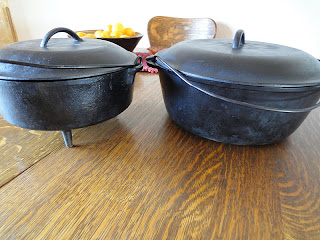I don’t have a lot of pots and pans. I don’t have any non-stick cookware. But, you may have noticed that several of the pictures show food cooking in a cast iron pan. When it comes to pots and pans, I’m old school.
Cast iron cookware has been around for centuries, and there’s a reason for that. Wikipedia says: “Cast iron's ability to withstand and maintain very high cooking temperatures makes it a common choice for searing or frying, and its excellent heat diffusion and retention makes it a good option for long-cooking stews or braised dishes.”
Martha Washington used cast iron. The pioneers emigrating west on the Oregon, Mormon and California trails used cast iron, too. Walt’s mother had a little set of cast iron pans when she was a little girl in the 1920s. Now our grandchildren play with this same little cook set. Aren’t they cute?
When Walt and I got married, one of our groomsmen gave us the gift of cast iron. We don’t have any of the sheets or towels from that time, but we do have those two dutch ovens – one is big and one is bigger. That’s in case I ever have to feed a small army, or take a pot of chili to the mountains when we cut Christmas trees with the family, or make a big roast for Sunday dinner.
I use cast iron for a variety of great recipes. A cast iron pan makes the best cornbread. I melt some butter in the pan as I’m mixing up the cornbread batter. I want the pan to be nice and hot when I pour the batter in. Then when the cornbread is done, it’s got beautiful crispy, buttery edges and comes out of the pan with no trouble.
Or if I want to make pot roast, I sear the meat in the dutch oven, add the potatoes and carrots and the liquid, and put the dutch oven in the oven to finish cooking for a couple of hours at low heat.
The same goes for stew. I can sear the meat, add the vegetables, and liquid, then simmer on the stove or put in the oven to finish cooking. There is no other cookware that is so versatile and durable.
 |
| Our home griddle - it seems to be able to float in the air |
Cast iron takes a few minutes to heat up, but when it does, everything will cook evenly and beautifully. It does help to have an oven mitt or hot pad when you are using cast iron because the handles get so hot. I have one of these clever little handle covers that doesn’t slip off the handle or get in the way of what I’m cooking.
Cast iron does leach miniscule amounts of iron into the food that’s cooking. For most people, that’s a beneficial thing unless you have a problem with excess iron.
I’m sure you’ve heard about seasoning cast iron and never washing it. Everyone has a different method of taking care of their cast iron. When you first get a piece of cast iron cookware, you need to wash it in hot soapy water and scrub it with a stiff brush. It’s got all sorts of nasty stuff on it from the factory and it’s ok to wash it.
Then, make sure you rinse it well and dry completely. Take some melted solid vegetable shortening like Crisco, or you can use cooking oil, but I like to use Crisco better. Rub the pan all over, inside and out, with a paper towel and the shortening. Put the pan on a rack in your oven; put some foil on the rack below the pan. Heat the oven to 300° and bake the cookware for about an hour. Turn off the oven, and let everything cool down.
Store the cookware, uncovered, in a dry place. My dutch ovens have lids and I either tip the lid to one side or store them separately. You don’t want any moisture to get inside the cookware and stay there.
This seasoning process provides a non-stick surface for cooking and protects the pan from rust.
Some people never wash their cast iron cookware. They will burn off the leftover food in the campfire, or just wipe out the pan with a paper towel. Some people will scrub their cookware with coarse salt and a paper towel. Just never, never wash cast iron in a dishwasher.
I was of the “just wipe it out” school until I took a dutch oven cooking class at an outdoor training this past summer. After cooking, the instructors washed their dutch ovens (and they had a pile of them) in hot, soapy water, dried them thoroughly, then applied a thin layer of shortening all over the dutch oven.
So, now I wash my cast iron in hot, soapy water, and dry it. Then I put it over a burner on the stove, let it get warm, and put a thin layer of shortening on the inside of the pan. The outside is still seasoned, so I only do the outside every few months in the oven. I do the inside every time I use the pan or dutch oven. This keeps the seasoning fresh, keeps the non-stick surface functional, and keeps the pan healthy for the next time I use it.
So the next time you need to buy a frying pan, go ahead and splurge on a nice cast iron one. Treated right, you’ll never need to buy another frying pan. Then you’ll want a dutch oven, then you’ll want a griddle, then a tortilla press, then...







No comments:
Post a Comment